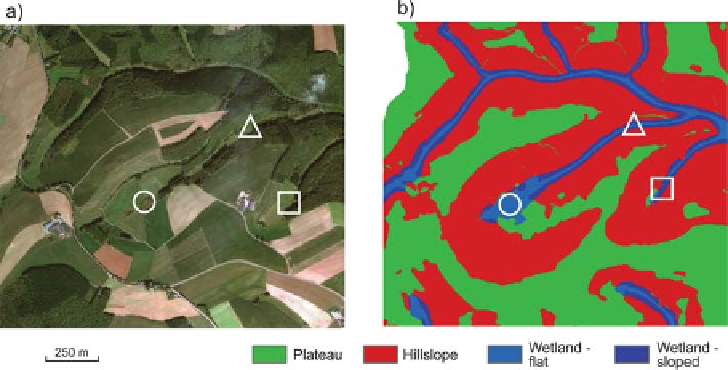Geography Reference
In-Depth Information
Figure 10.9. (a) Aerial photo of the
headwater of the Wark catchment,
Luxembourg; (b) categorised
landscape units based on
topographic analysis. Symbols
indicate identical positions on the
two maps. From Gharari et al.
(
2011
).
other usually dimensionless quantities) differ in terms of
the processes they aim to represent (Blöschl,
2005
).
A suitable choice of the similarity measures depends on
the dominant runoff generation mechanism one expects in
the catchments. In other words, similarity relates to the
prevailing feature of runoff generation and routing, rather
than similarity of hydrological systems as a whole (Kuch-
ment and Gelfan,
2009
). An example is the similarity
parameters based on the relative dominance of the infil-
tration excess and saturation excess mechanisms of Robin-
son and Sivapalan (
1995
; see
Section 9.2
). For the arid
steppe region where the infiltration excess mechanism of
runoff generation dominates, Kuchment and Gelfan (
2009
)
found that dimensionless indices derived from the
Richards equation work well as similarity measures to
transfer calibrated parameters from gauged to ungauged
basins. Also, there are cases where the similarity defined
on the available catchment/climate characteristics does not
fully map to the hydrological similarity (Oudin et al.,
2010
). Clearly, it is important to define what processes
are to be captured by the similarity measures and choose
them accordingly, within the limits of data availability, and
any additional data that may be collected, e.g. through field
visits.
Figure 10.10. Clusters of catchments according to their runoff
signatures in the eastern half of the USA. From Sawicz et al.(
2011
).
can be used in the entire region (see
Figure 2.10
). The
group of catchments can also be used to transfer the model
structure from gauged to ungauged catchments. Finally,
the grouping can provide insight into what are the main
runoff processes at the regional scale. The techniques used
for catchment classification are discussed in detail in
Section 5.2
. Here we discuss aspects that are specific to
runoff hydrographs.
10.2.3 Catchment grouping
On the basis of the similarity measures, catchments can be
grouped into regions that are considered homogeneous in
terms of runoff processes. For the purpose of estimating
runoff hydrographs in ungauged basins, catchment
grouping is needed for a number of purposes. Most import-
antly, if a group can be considered homogeneous in terms
of runoff processes, the same relationships between catch-
ment characteristics (e.g., soil depth) and model parameters
Grouping based on runoff similarity
Grouping of catchments can be done on the basis of one or
more of the runoff signatures discussed in
Chapters 5
to 9,
i.e., using the signatures as a measure of runoff similarity.
Figure 10.10
presents an example of catchment grouping
in the eastern half of the USA based on runoff similarity. In
this case, the signatures used were mean annual runoff
ratio, slope of the flow duration curve, runoff elasticity


Search WWH ::

Custom Search